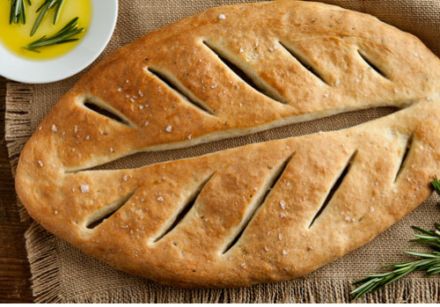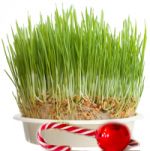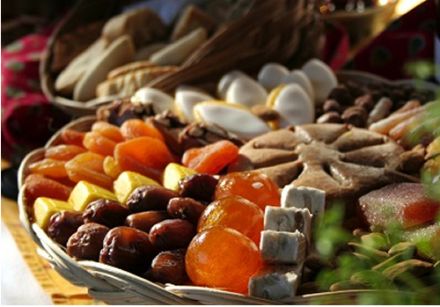 |
Flavors of Provence-Alpes-Côte-d'Azur
Holiday traditions of Provence, in the land of santons, fifes and drums,
scented by thyme, garrigue, and olive trees

In Provence, the holiday season is an enchanted time. Each village has its midnight mass and the traditional living crèche. Christmas also brings the arrival of the three kings, special dishes and long evenings around the fire…
Christmas Eve is a important day imbued with memories of the past, a time to re-enact age-old traditions centering around the crèche, which is filled with traditional figurines called santons. The finishing touches are put to the table for the first, smaller meal, le petit souper, which brings together the whole family at 7:00 p.m.: chicken soup swimming with big lacy noodles, a fine codfish fried with onions and olives, a capon or nice plump goose stuffed with truffles or prunes, accompanied by a gratin of Swiss chard cooked in the oven with the poultry juices, a winter salad sprinkled with garlic croutons, and a squash pie.
The meal goes on for hours. Between courses, everyone contributes stories and reminiscences, and the good raconteurs, amidst songs and music, tell the tale of the shepherds, the account of the Nativity, interspersed with anecdotes that provide a comforting feeling of home.
Still feeling full, everyone gets up to prepare for midnight mass. To the oldest guest at table falls the honour of laying the fire: that is, lighting the Yule log. Following tradition, the limb of a fruit tree (pear, cherry or olive) is sprinkled three times in succession with wine or olive oil, before being placed in the hearth for the "bouta cacho-fio": the lighting of the fire while the ritual sentence "A l'an qui vient, si li sian pas mal, qué li sieguen pas mén" is recited. (To the coming year: if it does not find us greater, may it not find us diminished.)
Next, the lady of the house places in the fireplace the squash in which soup will cook during midnight mass. Then comes mass itself. Shepherds and shepherdesses join in a procession to the church. The prior, before the altar, takes a lamb in his arms and begins the account of the voyage they have made across hills and valleys to come to adore the baby Jesus, who has just been born in the manger in this lambing season.
In the town of Saintes-Maries-de-la-Mer, shepherds, herdsmen and fishermen head to church, lanterns hanging from their tridents, while rows of domestic workers and gardeners from the plains of la Petite-Crau and the sides of the Alpilles wind over the mountain of Frigolet.
Upon return from midnight mass, it is time for the "big supper," a meatless meal, yet one rich in symbolism. The table is set with three tablecloths, one atop the other representing the three persons of the Holy Trinity - Father, Son and Holy Ghost - and lit by three candles. It is decorated with little holly branches with red berries, beautiful wood roses,

and St. Barbara's wheat, sown before December 4, her feast day.
There are seven dishes, representing the seven sorrows of the Virgin Mary.
After the squash soup (1), the first candle is extinguished and one tablecloth is removed, while care is taken to shake any crumbs and crusts of bread onto the second tablecloth.
Next the guests partake of snails (2) which have been cooked in court-bouillon and served in their reduced cooking liquid, well-flavoured with tomato. In Arles, it is not the custom to suck down the snails, but to remove them from their shells with a pin and to eat them with aioli, the famous garlic mayonnaise of Provence.
Every meatless meal implies the presence of fish, and the traditional dish remains dried, salted racks of cod, which when mixed with olive oil and milk, is served as brandade, (3), followed by mullet with olives and fried onions (4).
Next traditional vegetables are served (5): cauliflower, cardoons, celery and artichokes drizzled with virgin olive oil, in a white sauce or accompanied by the traditional anchoiade, a purée of anchovies, garlic and onions.
Then comes a salad of curly endive enlivened with garlic croutons (6).
And now, even though you're full, you still have to face the seventh course which consists of 13 desserts!
But before bringing out fruit bowls and platters, the second candle must first be blown out and the second tablecloth removed.
The seventh course is made up of thirteen desserts. It almost seems as if everything has been kept subdued until now in order to create a more sensational finale. There are the same number of desserts as there were guests at the last supper. There is no chestnut yule log, nor sorbet, as elsewhere in France, but instead a sampling of the natural bounty, the flavours of the autumn harvest, of the drying and jam-making season.

The desserts are brought out in strict order:
1. Fougasse (a flat bread) or pompe à l'huile, a leavened cake made from the finest flour, olive oil, orange flower water, and brown sugar;
2. White nougat with hazelnuts, pinenuts and pistachios;
3. Dark honey nougat;
The dried fruits and nuts known as the quatre mendiants, or "four beggars":
4. dried figs;
5. raisins;
6. almonds;
7. hazelnuts;
The six fruits:
8. Italian grapes kept in the attic, or winter pears;
9. jam made from quinces, fruits and grape juice;
10. oranges;
11. candied mandarins or citrons;
12. squash pie;
13. walnuts or dates.
The thirteen desserts are often accompanied by cherry ratafia, a fruit-imbued cordial; and carthagène, wine made with eau-de-vie. Then nothing remains to be done but to tie up the four corners of the third tablecloth into a bundle and take the leftovers of the supper to the poor.
"Pompe à l'huile", bread made with orange flower water, sugar and olive oil
Yule Log with Candied Fruit
Serge Peuzin, Auberge du Luberon-Peuzin, Apt
Fougasse Photo: L'Atelier du Boulanger

-

 Recipes
Recipes
-

 Products
Products
-

 Entertaining
Entertaining
-

 Chefs
Chefs
-

 Hints & Tips
Hints & Tips
-

 Glossaries
Glossaries








